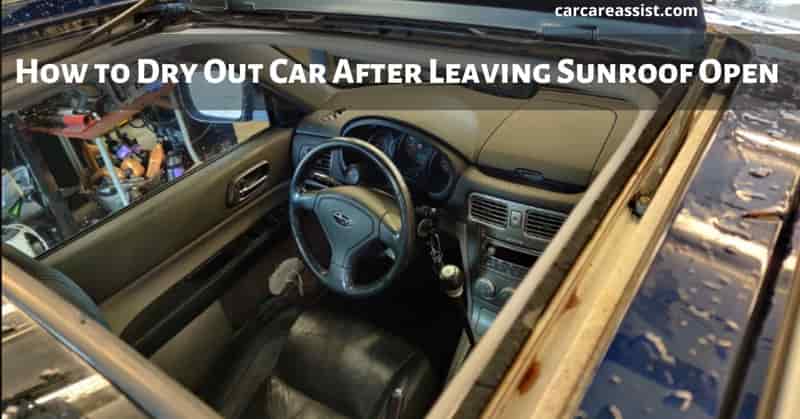How to Dry Out Car After Leaving Sunroof Open
If you’ve ever left your car sunroof open and it has rained, you know how frustrating it can be to try and dry out the interior. In this guide, I’ll show you how to dry out car after leaving sunroof open. Also, I will provide some tips on how to dry out your car quickly and effectively. Please follow my prevention methods so that you don’t have to worry about water damage in the future.
What type of problem causes if you leave your sunroof open and it rains
Water damage is the most common problem that occurs when a car’s sunroof is left open during rain. This can happen if the sunroof is left open for an extended period of time or if the car is parked in an area that doesn’t have good drainage. Water damage can cause mold and mildew to grow, and it can also lead to rust and other corrosion.
In addition, there are various issues that can occur. Like:
⚠️ Short out your car’s electrical system
⚠️ The water can soak through your upholstery and cause mold or mildew to grow.
⚠️ Cause rust and other corrosion on your car’s metal surfaces.
⚠️ Damage your car’s paint job.
⚠️ The water can cause your car’s interior to smell musty.
How to Dry Out Car After Leaving Sunroof Open
If you’ve left your car sunroof open and it has rained, the first thing you’ll want to do is dry out the interior as much as possible. First, you can use towels to remove the water from your car.
How to dry out the car using towels
Use towels to soak up as much water as possible, and then use a hairdryer on the low setting to dry out any remaining moisture. Be sure to target the areas under the seats and in the crevices of the door panels, as these are typically where the most water will collect.
If your car has leather upholstery, you’ll need to be extra careful when drying it out. Use a soft cloth to blot the moisture, and avoid scrubbing or rubbing the area too harshly. You may also want to apply a leather conditioner after the area is dry to help prevent any cracking or damage.
Use a dehumidifier
If your car is still feeling damp after using towels and a hairdryer, you can try using a dehumidifier. Place the dehumidifier in your car and close the doors to trap in the moisture. Run the dehumidifier for a few hours, or overnight if possible. This will help to remove any lingering moisture and dampness.
Using a dehumidifier in your car has several benefits:
➤ It helps to remove any lingering moisture and dampness.
➤ Prevent mold and mildew from growing.
➤ It can help keep your car’s interior smelling fresh.
➤ Protects your car’s upholstery from water damage.
➤ Prolong the life of your car’s paint job.
If you live in an area with a lot of rain or snow, investing in a dehumidifier for your car is a good idea. It will help to keep your car dry and prevent any water damage from occurring.
How to prevent water damage
One of the best ways to prevent water damage is to make sure your car’s sunroof is closed before it rains. If you know a storm is coming, close the sunroof and leave it closed until the rain has passed.
You should also consider investing in a sunroof cover. These covers can be placed over the sunroof when it’s not in use, and they’ll help to keep water out if it rains. Sunroof covers are especially helpful if you live in an area with a lot of rain or snow.
If you do find yourself with water damage, be sure to act quickly and dry out your car as soon as possible. The longer the moisture is allowed to stay, the more damage it can cause. Use the tips above to dry out your car and prevent any further damage.
FAQs
Q: Can rainwater damage my car’s paint?
A: Rainwater can damage your car’s paint if it’s left to sit for an extended period of time. The water can cause the paint to fade, and it can also lead to rust and other corrosion. If you notice any water spots on your car’s paint, be sure to clean them off as soon as possible.
Q: Can rainwater damage my car’s electrical system?
A: Rainwater can damage your car’s electrical system if it gets into the wiring. This can cause a short circuit, which can lead to a fire. If you notice any water in your car’s electrical system, be sure to have it repaired by a qualified mechanic.
Q: How can I prevent water damage to my car?
A: One of the best ways to prevent water damage is to make sure your car’s sunroof is closed before it rains. If you know a storm is coming, close the sunroof and leave it closed until the rain has passed. You should also consider investing in a sunroof cover. These covers can be placed over the sunroof when it’s not in use, and they’ll help to keep water out if it rains. Sunroof covers are especially helpful if you live in an area with a lot of rain or snow.
Q: Can rainwater damage my car’s interior?
A: Rainwater can damage your car’s interior if it’s left to soak in. The water can cause the upholstery to mildew or mold, and it can also lead to rust and other corrosion. If you notice any water spots on your car’s interior, be sure to clean them off as soon as possible.
Q: What should I do if my car gets wet from the rain?
A: If your car gets wet from the rain, the first thing you’ll want to do is dry it out as soon as possible. Use towels to soak up any water, and then use a hairdryer to dry out the area. You may also want to use a dehumidifier to remove any lingering moisture. Be sure to act quickly, as the longer the moisture is allowed to stay, the more damage it can cause.
Q: Can I drive my car in the rain?
A: Yes, you can drive your car in the rain, but you’ll want to take extra precautions to avoid any water damage. Be sure to drive slowly, and avoid puddles whenever possible. If your car does get wet, be sure to dry it out as soon as possible.
Q: Is it bad to leave my car in the rain?
A: Leaving your car in the rain is not recommended, as it can cause water damage. If you must leave your car in the rain, be sure to close the windows and sunroof to avoid any water getting inside. You should also consider investing in a car cover to help protect it from the elements.
Q: How long does it take for water damage to happen?
A: Water damage can happen almost immediately, or it can take days or weeks for the effects to show. It all depends on the severity of the water exposure and the type of materials that were affected. For example, wood is more susceptible to water damage than metal.
Q: How much does it cost to fix water damage?
A: The cost to fix water damage will vary depending on the extent of the damage. Minor water damage can often be repaired with a few simple tools, while more severe water damage may require the services of a professional.
Q: Is it ok to start the car without cleaning the water?
A: No, it is not ok to start the car without cleaning the water. Doing so could damage the engine and electrical system. If your car has been exposed to water, be sure to have it inspected twice before starting it.
Final Words
Water damage is a serious issue that can cause extensive damage to your car. If you notice any water spots or leaks, be sure to clean them off as soon as possible. You should also avoid driving in the rain if possible, and be sure to dry out your car if it gets wet. If you have any concerns about water damage, be sure to follow the steps I’ve mentioned in this article.
Thanks for reading!







